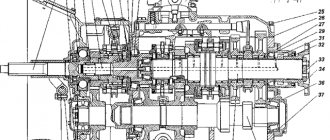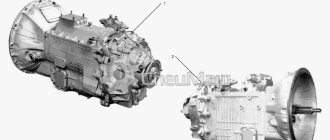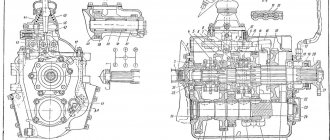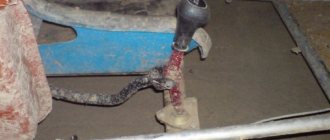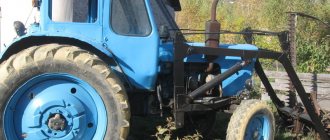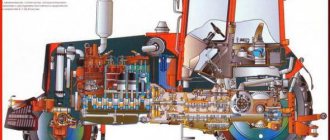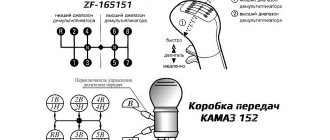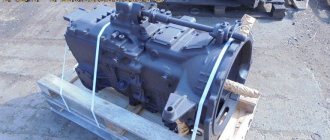The model 152 gearbox has been used on KAMAZ trucks since 2000. This unit has proven itself to be reliable and maintainable, therefore it is produced in different modifications to the present day. The transmission consists of a five-speed gearbox and a front splitter gearbox with two stages.
KPP-152 is an improved version of the 15th model. The modernization meant strengthening the previous version of the box in several areas.
The box has ten gears, it includes a divider, and all switching is carried out mechanically. As an improvement, the input shaft and shift mechanism were strengthened. These parts have become more resistant to mechanical stress. To increase the service life of the transmission by 20%, the synchronizer carriage spline joint lock was improved. Thus, the model is noticeably more reliable than the 15th version.
The updated transmission is installed on trucks of the following models: KamAZ 55111, 53215, 54115, 65115, including vehicles with all-wheel drive. The gearbox is supplied with special attachments for controlling gears and is additionally equipped with a clutch. Thanks to its increased reliability and load resistance, the Model 152 is installed on tractors used as the driving element of road trains.
The presence of a divider and a five-speed gearbox in the system allows for a full 10 gears. They are divided into higher and lower. This option for organizing the system is the most optimal from the point of view of efficiency and economy.
Installing a divider can significantly improve the traction and economic performance of the car, in addition, the device has a positive effect on the car’s handling, and the driver will less often need to change gears using the appropriate lever.
When creating the 152nd transmission model, the engineers' main goal was to strengthen the 15th transmission model so that it would be able to withstand greater levels of stress and mechanical wear. The first solution was to increase the size of the teeth in the gears, which allowed them to cope with higher mechanical loads. At the same time, the problem of turning off 4th and 5th gears was solved, for which a special locking mechanism was developed and installed, implemented by intersecting teeth. Some components of the system were removed to make it technically simpler, which also had a positive effect on the overall level of reliability of the device.
Specifications and data
Shaft bearings
When considering this component, it should be noted that depending on where the bearing is used in the shafts, its type changes. The primary shaft of the divider uses ball bearings, and the rear support of the divider shaft uses roller bearings with a missing inner ring. The situation is similar with the gearbox input shaft support.
If the secondary shaft is considered, then a roller bearing is installed in front and a ball bearing in the rear. The intermediate shaft is supported by a roller bearing at the front and a double-row spherical bearing at the rear. Such differences in the bearings used are explained by the technical features of the units, as well as the need to ensure better performance characteristics. With this configuration, the system achieves the greatest stability and reliability.
Synchronizers
The 152 transmission uses inertia synchronizers with brass cone rings installed. All gears, except those used for first gear and reverse, have helical teeth of constant mesh.
During operation, serious friction occurs, which can quickly damage the device. To prevent this problem, a combined lubrication system is used. Each component is lubricated using a spray arm, and a special pressure pump is installed to provide oil flow to the gearbox and splitter bearings. This minimizes friction and damage to the box.
Control
The gearbox is controlled mechanically. Switching of the main box is carried out thanks to a remote drive. The mechanism can be with direct or side exit.
Let's look at the transmission gear ratios:
Gear ratios
- 1H - 7.82
- 1B - 4.03
- 2H - 2.5
- 2B - 1.53
- 3H - 1
- 3B - 7.38
- 4H - 1.53
- 4V - 1.25
- 5H - 1
- 5V - 0.815
- 3ХН - 7.38
- 3ХВ — 6.02
Characteristics of the 152 transmission system on KAMAZ
Appearance of gearbox 152
The transmission system allows changes in engine torque. The gearbox consists of a 5-speed manual and a divider, which provides 10 additional forward speeds, as well as 2 reverse gears. This gearbox is characterized by a high degree of reliability, long service life and overhaul life.
The box includes the following parts:
- crankcase, with primary, secondary and intermediate shaft;
- top cover of the box;
- mechanism responsible for changing speed modes;
- gear block;
- divider.
The gear block ensures that reverse gear is engaged. This type of gearbox has a double-disc clutch. The driven disk can be equipped with non-asbestos friction linings. Since the shafts take on high loads during operation, they are made of wear-resistant material.
The gear bearings are double-row roller bearings and can withstand the loads very well. Inertial type synchronizers, complemented by conical rings. They provide smooth gear shifting and also reduce noise when changing gears.
The basis of the box air distributor is a cast housing. The air distributor includes air ducts that are located on the divider housing. This mechanism is securely fixed in the seat. Its maintenance consists of checking the tightness of components and pipelines. If an air leak is detected, it seems possible to solve the problem by tightening connections or replacing deformed components.
Transmission diagram 152
The manual transmission, supplemented by a divider, allows for wide range adjustment of traction and speed characteristics. As a result, the efficiency of vehicle control increases.
Gear ratios. As for the gear ratios, in the 1st low gear the indicator is 7.82, while in the 2nd – 4.03, 3rd – 2.5, 4th – 1.53, 5th – 1.
The box diagram shows that on this type of transmission the speedometer drive is two-stage. As for the lubrication system, it is combined on the mechanics, i.e. The working mechanisms of the box are lubricated by spraying.
Design features of KPP-152
After the implementation of new engineering solutions in box 152, its components were no longer suitable for repairing box 15. There is quite a common opinion on the Internet that the transmission of the 15th model can be repaired using components of the 152nd. This position is argued by the fact that the main difference between the systems is the size of the synchronizers and the depth of the splines, but this is not true. An important feature is that paired mechanisms must have all identical parts. Because of this, it is highly not recommended to repair the 15th gearbox with parts 152.
The intermediate shaft and its components from the Model 152 transmission cannot be installed in place of the same parts in the Model 15 transmission.
Such design differences place great demands on the attentiveness of the technician, who must strictly monitor the markings of parts for these two transmission models.
From the point of view of technical design, the 152nd box is most similar to the 142nd model. The differences are in small details that had to be changed to successfully use the gear divider:
- Changing the technical structure of the input shaft and rear bearing.
- Replacement of the front support elements of the input shaft.
- Changing fastening components.
- The oil reflection function is assigned to the spacer sleeve. She replaced the oil injection ring.
- Additional holes appeared between the oil baths in the crankcase.
- To regulate the axial stroke, two steel spacers are used. Their thickness is 0.2 and 0.3 mm, respectively.
KAMAZ 152 gearbox - the main causes of breakdowns
Malfunctions in the transmission system arise as a result of natural wear and tear of their mechanisms. Repair of this gearbox may involve installing new bearings, cuffs and other components related to the gearbox.
The main signs of a breakdown in the transmission system:
- Difficulty switching on speed modes.
- unauthorized switching off of gears.
- Speed limits when moving have become worse.
- oil leak.
The main reason for gearbox oil leaks is the loss of elastic properties of the cuff. This accessory part needs to be replaced.
If extraneous noises begin to be noted during movement, the reason for this is wear of the gear teeth. The gears should not be chipped. One of the reasons for bearing failure is a malfunctioning clutch (adjustment is required).
It is advisable to check the remote drive if the gears start to engage worse. The problem of difficult switching on speeds can be solved by its correct adjustment. You should also pay attention to the breather. This element must be kept clean.
Difficulty shifting gears is often associated with the presence of a reduced amount of gear oil in the gearbox. The quality of the fuel must be checked if sharp jerks are observed when changing speeds.
Gear divider
The 152 transmission uses a mechanical divider that includes one pair of gears. It is controlled by a pneumatic control system.
To regulate the axial movement of the drive shaft, a set of metal spacers is used, the thickness of which is 0.2 and 0.3 mm, respectively. They are located in the area between the back cover and the outer race of the ball bearing. To prevent the gears from being switched off arbitrarily, a lock is installed in the divider, consisting of the teeth of the outer and middle rims. An inertial type movable finger synchronizer is additionally installed on the splines.
Differences between 152, 15 and 154 KamAZ transmissions
First of all, you should pay attention to the support of the block that controls transmission shifting. By its marking you can easily determine which gearbox is installed in a particular vehicle. Over time, you can begin to notice the design differences between these components.
Now you can find a large number of commercial vehicles with 15-series shift mechanisms, which are almost completely out of production due to obsolescence. A serious difference in their design from the new models lies in the tubes connecting the valves and the air distributor.
List of the most significant differences between the 152nd and 15th series gearboxes:
1) Teeth size. In the 152 series they are noticeably larger, which significantly increases the strength of the mechanism.
2) The pneumatic control system has become much simpler. The engineering scheme has undergone changes; new plastic air ducts connected to the control valve have been introduced. At the same time, the extra air ducts and the box securing them were removed.
3) To increase the load-bearing characteristics of the 4th gear, the diameter of the crown of its gear was increased.
Completeness of KamAZ 152 gearbox
If we consider the components of the 152nd transmission, we can distinguish the following components: clutch and clutch control system, three shafts (drive, intermediate and driven), crankcases, supports, divider, divider input shaft, various types of fasteners, gaskets, washers, bolts and bearings of various variations. Thanks to all these components, the full functioning of the system is ensured.
Features of maintenance of gearbox 152
Any device and equipment requires periodic technical inspection, during which the condition of individual components and systems will be determined. The 152 gearbox is no exception.
Below is a list of the most common maintenance jobs for this model:
- Initial inspection and check of serviceability of the divider control cable. If malfunctions are detected, they are eliminated.
- Visual inspection aimed at detecting oil leaks through the installed gaskets and the driven shaft seal.
- Adjusting the position of the shutter between the travel stop and the stop.
- Lubrication work in the area of the front and intermediate linkage of the remote control gearbox control drive.
- Cleaning the breather from dirt.
- Checking the condition of the gearbox housing and the oil level in it.
- Replacing the lubricant in the crankcase.
- Lubrication of cables.
The procedure for checking the oil level in the crankcase is mandatory, and the algorithm for its implementation is extremely simple. It is necessary to remove the oil filler plug, clean the scale with indicators, and then insert the plug back. After this, it will be possible to draw a conclusion about the existing oil level. It is necessary to regularly check the oil level to prevent the box from overheating.
Features of changing gearbox oil
The procedure for changing the transmission oil is carried out after certain periods of time specified in the technical data sheet. When the vehicle is under increased load or is operating under unfavorable conditions, it is necessary to change the oil more often.
Before changing the oil, the vehicle must be preheated. After this, the hot oil is drained using special drain valves and all valves are cleaned. If necessary, they can be replaced with new ones. Next, engine oil is poured into the crankcase to clean the system. For the greatest effect, you need to turn on the engine so that it circulates the oil in the box. The washing procedure takes ten minutes. After this, the engine oil is drained and the main lubricant is added. At the end of the entire procedure, it is important to check the lubricant level. For this purpose, you need to start the vehicle again and let the gearbox run for 5 minutes in the neutral position. Then the existing fluid level is checked and more is added if necessary.
In this case, the highest quality cleaning of the system is ensured, which will extend its service life.
Possible faults
The most common breakdowns of the 152nd transmission and methods for repairing them:
- The appearance of a grinding noise when changing gears, engaging 1st or reverse gear requires considerable effort. The cause of this problem is incomplete disengagement of the clutch, which causes additional interference. The solution to the problem involves influencing the clutch so that it begins to move freely.
- Changing all gears requires considerable effort. In most cases, the problem is caused by a large amount of dirt and thickened oil on the control drive. To solve the problem, wash these components with a special cleaner and subsequently apply new lubricant.
- Extraneous noise and grinding noise in the divider. In most cases, the problem is caused by exceeding the pressure in the system. To solve this problem, you will need to adjust the operation of the pressure reducing valve.
- Reducing valve diaphragm rupture. The reason is the resource depletion of conical rings. The fragment will need to be replaced.
- The shift forks are out of order. The exhaust air ducts should be checked. To restore the mechanism, you will need to disassemble it and thoroughly clean it, and then lubricate the cleaned surfaces.
- Gears change randomly while driving. This indicates that the latches or shift forks are broken. These components should be replaced and the fasteners checked for tightness.
- The transmissions stopped turning on. The reason is severe wear of drive parts. Any broken components will need to be replaced.
- Wear of brass rings. There are two solutions: check the adjustment of the switch valve stop and replace the synchronizer.
The following two issues deserve special attention:
1) Loud noise during transmission operation.
There are several reasons for such a breakdown:
- Severe wear of parts. Bearings, gears, or other system components will need to be replaced.
- Oil leaking from the box. It is necessary to replace the gasket and add oil.
- Loss of elasticity of oil seals. Replacing oil seals.
- Increased pressure in the crankcase. The breather needs to be cleaned.
- The sealing surfaces have become depressurized. The condition of the fastening elements will need to be checked.
2) Problems with gear shifting in the divider;
The most common causes and repair methods:
- The air distributor pistons became dirty, causing them to jam when moving. The device needs to be cleaned.
- The valve stop has moved. Return to original position.
- Valve stop broken. Component replacement.
- The pneumatic divider control system is dirty. Special cleaning of the system is carried out.
→ It is very important to promptly detect all of the above breakdowns before they cause significant damage to other vehicle systems.
Features of a gearbox with a pneumomechanical control system
The gear divider improves the traction and economic qualities of KAMAZ and ensures a gentle operation of the automotive system. Taking this into account, a machine with a manual transmission of this model can be used in many industries that are associated with cargo transportation. The pneumatic gear shift system of the divider includes a pressure reducing valve. Its function is to maintain a constant level of outlet pressure.
The gear divider activation valve includes the following elements:
- valve spring housing;
- pad;
- inlet valve with spring;
- valve stem with spring;
- body, valve cover;
- breather.
Also, there is a sealing gasket, a cotter pin, a washer, a dust protector, a ring, and a rod stop. It should be noted that the pneumatic diagram of the gear divider control system displays the presence of a speed change mechanism.
Thus, the KAMAZ 152 high-speed box with a divider provides comfortable conditions for transporting goods. The installed pneumatic brake drive allows you to create virtually unlimited driving force from the brake mechanisms. Thanks to the gearbox divider, the number of manual shifts made by the driver is minimized.
Features of changing the oil in the box
TSp-15K
How to change transmission oil? To drain the fluid from the mechanics, unscrew the three drain holes. They are located at the bottom of the crankcases. You also need to pay attention to magnets. These elements are cleaned of settled dirt.
The crankcase together with the divider must be flushed with oil. Typically, this requires about 12 liters. Next, you need to move the lever to the “N” position for about 10 minutes, after which the liquid drains and the drain plugs are tightened. At the last stage, gear oil is added to the upper mark of the level indicator. This procedure can be carried out independently.
What kind of oil should I put in a manual transmission? For this device it is recommended to use TSp-15K. It has an optimal viscosity index, provides effective protection of transmission parts from wear, and reduces the risk of fuel foaming.
TRUCKS GAZ, ZIL, KAMAZ, URAL, MAZ, KRAZ
_________________________________________________________________________________________
Design of gearbox 152 with a divider for Kamaz-43118, 55111 vehicles
Gearbox 152 with a divider is installed on Kamaz-4326, 43114, 43118, 55111, 43253 tractor vehicles. On KamAZ tractor vehicles intended for operation as part of road trains, a modernized ten-speed gearbox Gearbox 152 is used, consisting of the main five-speed Kamaz gearbox and front two-stage reducer-divider. The Kamaz 152 gearbox divider has high and low gears and, in combination with the main five-speed gearbox, allows for ten forward gears and two reverse gears. The use of a gear divider improves the traction and economic qualities of the car, makes it easier to drive the car, since its use reduces the frequency of gear shifting with the shift lever. During the modernization, the splines of the input shaft of the divider of the 152 Kamaz gearbox were strengthened, as well as the couplings of the input shaft gear and the synchronizer coupling of the divider by increasing the height of the tooth; a keyless connection of the gear and the intermediate shaft of the divider was used. Design differences between the Kamaz-152 gearbox and model 15: - the splines of the input shaft of the divider, carriage, input shaft gear and synchronizer clutch are strengthened by increasing the height of the teeth; — a keyless connection is used between the gear and the intermediate shaft of the divider; — the locking device in the splined connection between the 4th...5th gear synchronizer carriage and the secondary shaft is eliminated; — to prevent the 4th and 5th gears from turning off automatically, the angle of the clutch teeth of the 4/5 gear synchronizer carriage and, accordingly, the teeth of the input shaft clutch and the 4th gear gear have been increased, and the height of the clutch teeth has been increased; — the ring gear of the 4th gear is expanded. The input shaft of the gearbox divider 152 Kamaz-55111, 43114, the input shaft gear and the synchronizer gear coupling of the model 152 gearbox are not interchangeable with similar parts of the model 15 gearbox.
The model 152 gearbox divider synchronizer can be installed in the model 15 gearbox divider. The intermediate shaft gear of the gearbox divider 152 Kamaz-55111, 43114 and the intermediate shaft of the model 152 gearbox divider itself are not interchangeable with similar parts of the model 15 gearbox. When repairing Kamaz gearboxes -152, you should pay attention to the marking of the above-mentioned parts, which begins with the number 152. The main five-speed gearbox Kamaz-152 is maximally unified with gearbox 142, except for a small number of parts, the design changes of which are caused by the use of a gear divider: - the design of the input shaft and cover has been changed rear bearing. There is no gasket between the cover and the gearbox housing; — the front support of the input shaft of the gearbox 152 KamAZ-55111, 43114 is a roller bearing located in the hole of the divider input shaft; — instead of an oil injection ring on the shaft, a synchronizer coupling is secured with a nut on the splines; — the front cover of the intermediate shaft is missing; instead, the axial displacement of the front bearing of the intermediate shaft is limited by a spacer sleeve, which is also an oil slinger; — the oil baths of the gearbox and the Kamaz-152 divider are connected to each other by two holes located in the lower part of the front end of the gearbox and in the rear wall of the divider. The axial stroke of the input shaft is controlled by steel spacers 0.2 and 0.3 mm thick. Technical characteristics of the Kamaz 152 gearbox with a divider Gear number and gear ratios: 1st reverse - 7.82; 1st forward – 4.03; 2nd back – 2.5; 2nd forward – 1.53; 3rd back – 1; 3rd forward – 7.38; 4th back – 1.53; 4th forward – 1.25; 5th back – 1; 5th forward – 0.815; Reverse gear - 7.38/6.02 Gearbox shaft bearings 152 Kamaz - Ball bearings are used in the supports of the primary shaft of the divider; the front support of the intermediate shaft of the divider is a ball bearing, and the rear support is a roller bearing without an inner ring. In the supports of the input shaft of the gearbox 152 Kamaz-55111, 43114, a roller bearing without rings is used at the front, and a ball bearing at the rear. For the secondary shaft of the gearbox, front roller and rear ball bearings are used. The intermediate shaft of the Kamaz 152 gearbox rests on a roller bearing at the front, and at the rear on a double-row spherical roller bearing. Gear bearings for the KAMAZ 152 gearbox are double-row roller bearings with cages without rings, fourth gear gear bearing without a cage. Gearbox synchronizers 152 Kamaz are inertial type, finger type with brass conical rings. Kamaz 152 gearbox gears have helical teeth, except for first gear and reverse gear, constant mesh. The Kamaz 152 gearbox lubrication system is combined. All parts are splash lubricated; the gearbox and divider gear bearings also have additional feed from the oil injection device. Power take-off - from the main gearbox on both sides through hatches in accordance with GOST 12323-66; On the right side - from the ring gear of the reverse gear block; on the left - from the ring gear of the reverse gear of the intermediate shaft; it is possible to install a PTO instead of the top gearbox cover. Gearbox control 152 Kamaz-55111, 43114 is mechanical, with a remote drive for the main gearbox and pneumatic preselector for the divider. Speedometer - the speedometer drive is two-stage, consists of a permanent worm pair and a replaceable pair of spur gears. Kamaz-152 gearbox design
Fig.1. Gearbox Kamaz-152 1 - primary divider shaft; 2 — rear bearing cover of the divider input shaft; 3, 9, 30 — adjusting gaskets; 4 — front roller bearing of the input shaft; 5 — primary gearbox shaft; 6 — ring nut; 7 — washer; 8 — synchronizer clutch; 10 — cover of the rear bearing of the gearbox input shaft; 11 — jet propulsion bracket; 12-lever support; 13 — lever; 14 - key; 15 — roller; 16 - nut; 17 — adjusting bolt; 18 - gasket; 19 — axis of the reverse gear block; 20, 38 — thrust washers; 21 — reverse gear block; 22 — roller bearing; 23 - bolt; 24 — lock washer; 25 — top cover; 26, 39 - sealing gaskets; 27 — cover of the rear bearing of the secondary shaft; 28 — retaining ring; 29 — rear ball bearing of the secondary shaft; 31 — speedometer drive worm; 32, 47 — sealing cuffs; 33 — flange mounting nut; 34 — driveshaft mounting flange; 35 — cup of the rear bearing of the intermediate shaft; 36 - bearing cover; 37 — spherical roller bearing; 40 — intermediate shaft; 41 — gearbox housing; 42 — secondary shaft; 43 — main five-speed gearbox; 44 — spacer sleeve; 45 — sealing gasket; 46 — gear divider; 48 — clutch release fork; 49 - clutch release fork shaft; 50 - clutch release clutch. Gear divider Gearbox 152 Kamaz -55111, 43114- mechanical gearbox consists of one pair of spur gears, input and intermediate shafts, synchronizer and gear shift mechanism. The gear shift mechanism is controlled pneumatically. The axial stroke of the input shaft of the Kamaz-152 gearbox is regulated by a set of metal spacers with a thickness of 0.2 and 0.3 mm, installed between the rear cover and the outer ring of the ball bearing. At the rear end of the shaft, involute splines are divided into three crowns by two grooves. The teeth of the outer rings are thinner than the teeth of the middle ring to create a “lock” that prevents the gears in the divider from switching off on their own. A finger-type inertial synchronizer is movably mounted on the splines. The drive gear of the gearbox 152 Kamaz-55111, 43114 rotates on two roller bearings. The oil injection ring supplies oil through the inclined drillings of the input shaft into its internal cavity, from where it enters the channels of the primary and secondary shafts of the main gearbox. The intermediate shaft of the Kamaz-152 gearbox divider with a pressed-on intermediate shaft drive gear rotates on two bearings: front and rear. The gear shift mechanism of the gearbox divider 152 Kamaz is mounted on the divider housing on the left. Gearbox 152, used with serial clutch KamAZ 142 Gearbox Kamaz 152.1700050 - Gear shift lever support 14.1702200-10 (series), flange 142.1701240 with end splines, divider 152.1770010-30 (with bracket 15.1772327 and metal tubes), divider input shaft 152.1770044 (splines serial Ø 42), rear bearing cover of the secondary shaft 14.1701200 (14.1701205) wide for the speedometer. Kamaz gearbox 152.1700053 - Gear shift lever support 14.1702200-10 (series), flange 152.1701240 (large round), divider 152.1770010-30 (with bracket 15.1772327 and metal tubes), divider input shaft 152.1770044 (splines serial Ø 42), secondary rear bearing cover shaft 14.1701200 (14.1701205) wide for the speedometer. Installed on a car without a pedal valve for switching on the divider. Kamaz gearbox 152.1700050-90 under the PTO from the intermediate shaft - Gear shift lever support 14.1702200-10 (series), flange 142.1701240 with end splines, divider 152.1770010 (without bracket 15.1772327 and metal tubes), divider input shaft 15 2.1770044 (series splines Ø 42) 14.1701048 -90 flush shaft, rear bearing cover of the secondary shaft 14.1701200 (14.1701205) wide for the speedometer. Kamaz gearbox 152.1700070-90 - Gear shift lever support 14.1702200 (side outlet), flange 152.1701240 (with end splines), divider 152.1770011 no bracket and metal tubes, divider input shaft 152.1770044 (serial splines Ø 42) 14.1701048-90 shaft, rear bearing cover secondary shaft 14.1701200 (14.1701205) wide for the speedometer. Installed on a car without a pedal valve for switching on the divider.
_________________________________________________________________________________________
- GAZ-3307 clutch maintenance
- Steering system GAZ-3307
- Gearbox parts for GAZ-3307
- Maintenance of the rear axle GAZ-3307
- Maintenance of the fuel system of the D-245 diesel engine
- Clutch GAZ-3309 with a diesel engine
- Operations for disassembling the GAZ-3309 gearbox
- GAZ-3309 front axle service
- Repair of cardan shafts of GAZ-3309 cars
_________________________________________________________________________________________
_________________________________________________________________________________________
- Operations for assembling basic components of the ZIL-130 engine
- Service and repair operations for the ZIL-130 gearbox
- Maintenance and repair of ZIL-130 clutch
- Repair and adjustment of the rear axle ZIL-130
_________________________________________________________________________________________
- KAMAZ-4310, 43118, 43114
- KAMAZ-5320, 55111, 53212, 5511, 55102
- KAMAZ-65115, 6520, 65117
- KAMAZ-4308
- Engine KAMAZ-740
_________________________________________________________________________________________
- Parts of the cylinder block and head of the YaMZ-236 engine
- Service maintenance of the YaMZ-236 piston group and crankshaft
- Diagnostics and technical adjustments of the YaMZ-236 engine
- Design and adjustment of fuel injection pump and injectors of the YaMZ-236 engine
- Cylinder block and piston YaMZ-238
- Components of the YaMZ-238 diesel fuel supply system
- Design and adjustment of the fuel injection pump of the YaMZ-238 diesel engine
- Technical design of the YaMZ-239 gearbox
_________________________________________________________________________________________
- Components of the front axle and steering rods of the Maz-5516, 5440
- Steering system of Maz-5516, 5440 cars
- Clutch and gearbox parts Maz-5516, 5440
- Maintenance of drive axles of MAZ-5516, 5440 vehicles
- Power steering for Maz-5551, 5335 cars
- Maintenance of cardan transmission of Maz-5551, 5335 cars
- Maintenance and adjustment of clutch MAZ-5551, 5335
- Repair and service of the rear axle of MAZ-5551, 5335 cars
_________________________________________________________________________________________
- Gearbox Ural-4320
- Construction and adjustment of Ural-4320 bridges
- Maintenance of transfer case Ural-4320
- Steering components Ural-4320
_________________________________________________________________________________________
- Servicing the KRAZ-255, 260 gearbox
- Steering mechanism and power steering Kraz-255, 260
- Adjustments and repairs of the power steering cylinder and steering rods of the Kraz car
- Drive axle components and drive shafts Kraz-255, 260
Manual Transmission Service
KAMAZ equipped with gearbox 152 is perfect for moving off-road or on construction sites. The type of transmission present makes driving the vehicle much easier. Thanks to the presence of a divider, the need for frequent gear changes is reduced.
With regular maintenance of the KAMAZ pneumatic system, the divider control system will work reliably. Thanks to this, high-quality switching of speed modes will be ensured.
Maintenance of the 152 KAMAZ gearbox implies:
- adjusting the drive responsible for changing speeds;
- measuring the gap in the divider activation valve;
- changing transmission oil.
As a rule, difficulties when engaging gears arise as a result of violation of the adjustments of the gearbox mechanisms.
Transmission fluid must be replaced at least once per calendar year. This procedure must be carried out on a warm engine.
